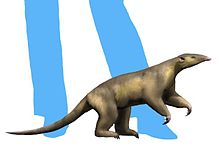Eurotamandua
| Eurotamandua Temporal range: Early Eocene,
| |
|---|---|

| |
| Fossil | |
| Scientific classification | |
| Domain: | Eukaryota |
| Kingdom: | Animalia |
| Phylum: | Chordata |
| Class: | Mammalia |
| Order: | Pholidota |
| Family: | †Eurotamanduidae |
| Genus: | †Eurotamandua Storch, 1981 |
| Type species | |
| Eurotamandua joresi Storch, 1981
| |
Eurotamandua ('European tamandua') is an extinct genus of mammal that lived some 47 million years ago, during the early Eocene.

A single fossil is known, coming from the Messel Pit in southwestern Germany. It was about 90 cm (3 ft) long. It is often classified as a pangolin. When it was first discovered, it was originally thought to be an anteater, as it lacked the characteristic fused-hair scales of other pangolins. Eurotamandua's placement within the pangolins was made primarily because of a lack of the characteristic "xenarthran" joints found in all xenarthrans, such as tamanduas. Eurotamandua may still be a stem xenarthran, but likely belongs to another group entirely, the Afredentata (probably part of Afrotheria).[1] While a distinct taxon, it is possible that Eomanis krebsi is also not a pangolin and belongs to this same group.[2]
Paleobiology
Eurotamandua bears characteristics found in almost all ant-eating mammals: long claws, a strongly elongated snout and most likely the same long, sticky tongue. Presumably it also fed on ants and termites.[3] The generic name comments on the strong, albeit possibly superficial resemblance to modern arboreal anteaters of the genus Tamandua, especially with its long, prehensile tail.
References
- ^ Hunter, John P. and Janis, Christine M. 2006. Spiny Norman in the Garden of Eden? Dispersal and early biogeography of Placentalia. J Mammal Evol 13:89–123
- ^ Horovitz, Ines et al. 2005. Ankle structure in Eocene pholidotan mammal Eomanis krebsi and its taxonomic implications. Acta Palaeontol. Pol. 50 (3): 545–548
- ^ Palmer, D., ed. (1999). The Marshall Illustrated Encyclopedia of Dinosaurs and Prehistoric Animals. London: Marshall Editions. p. 209. ISBN 1-84028-152-9.
